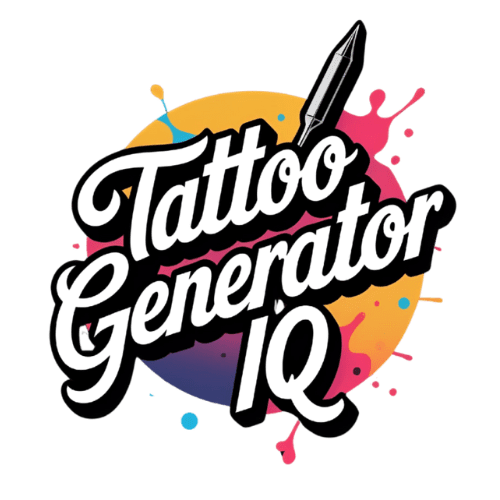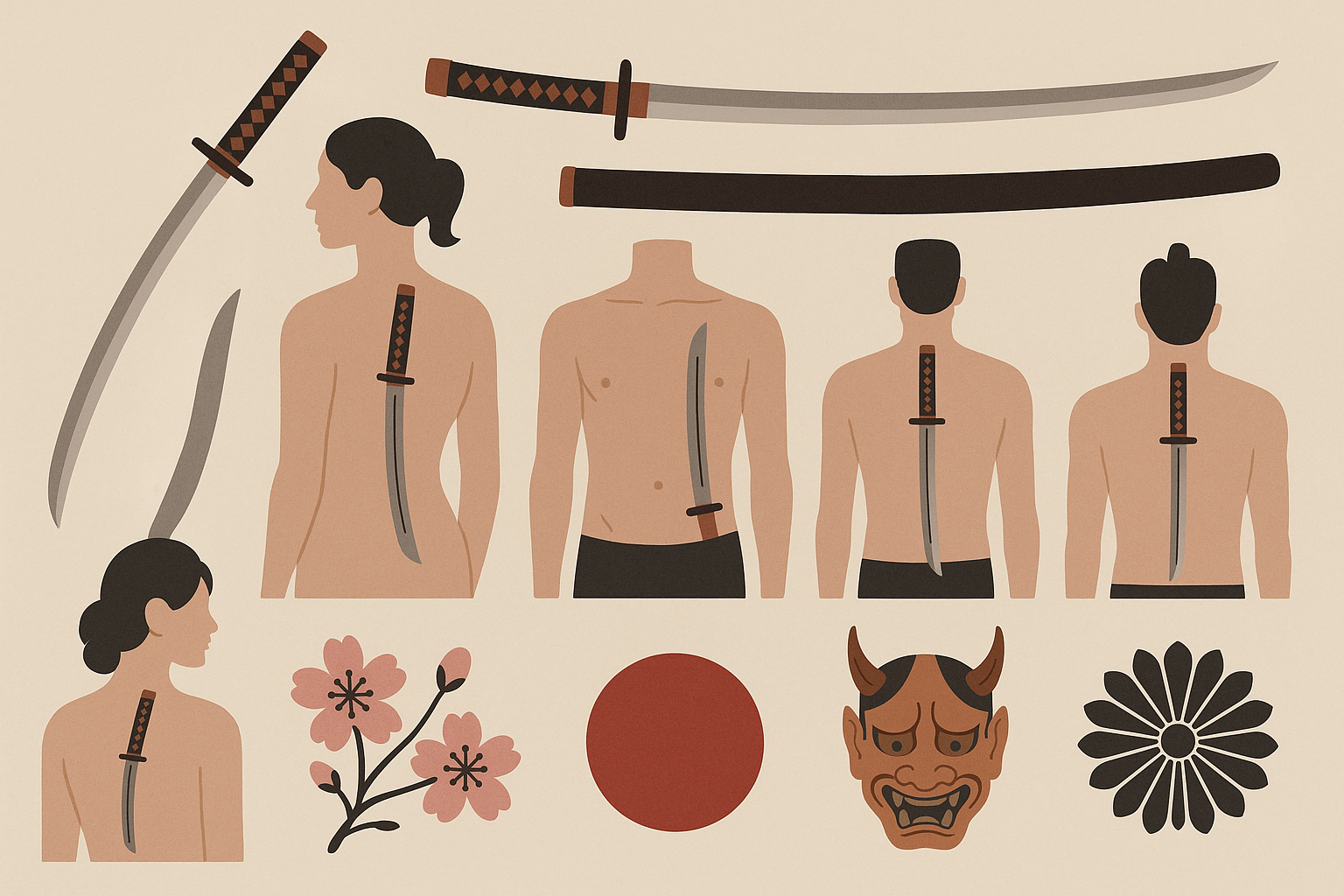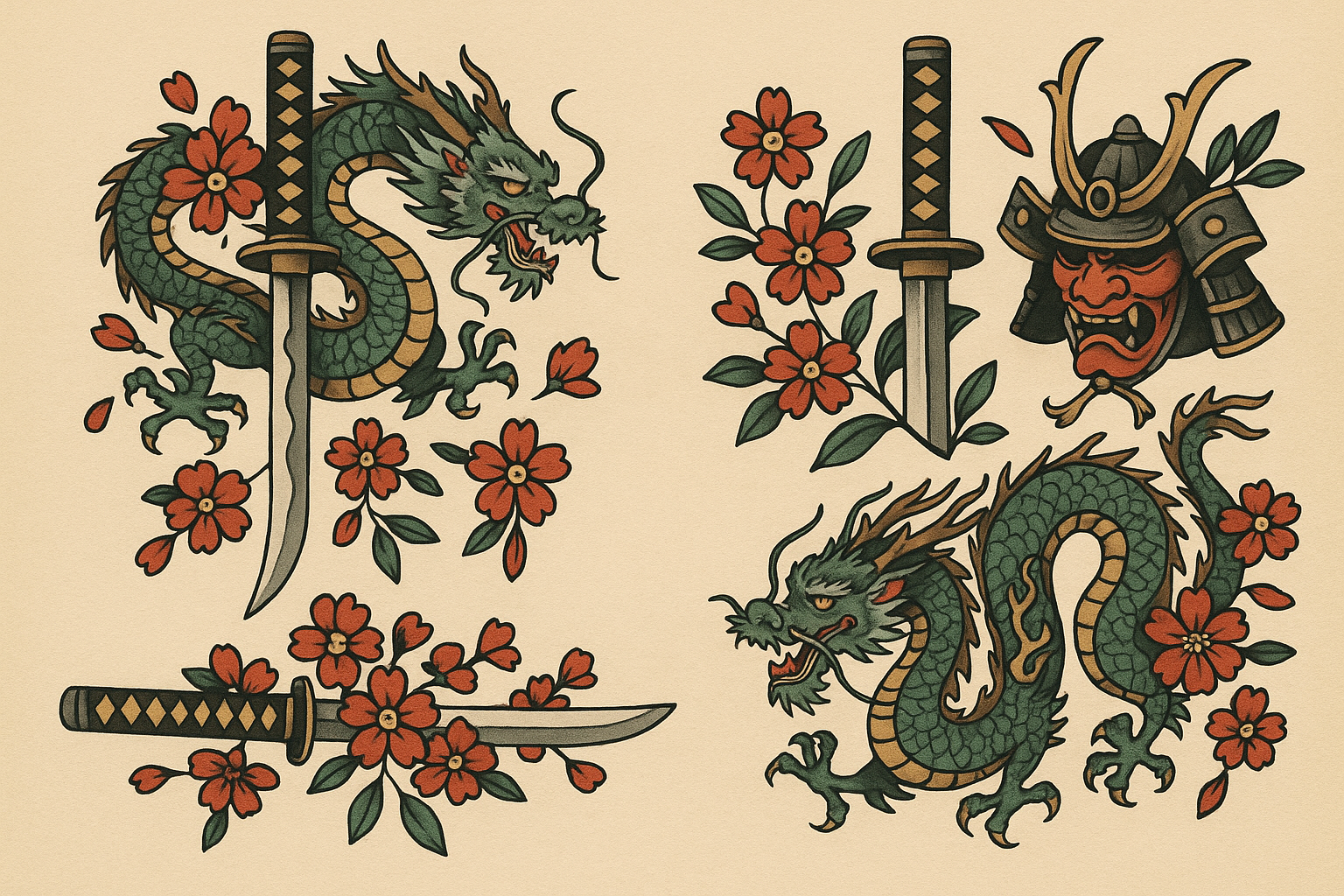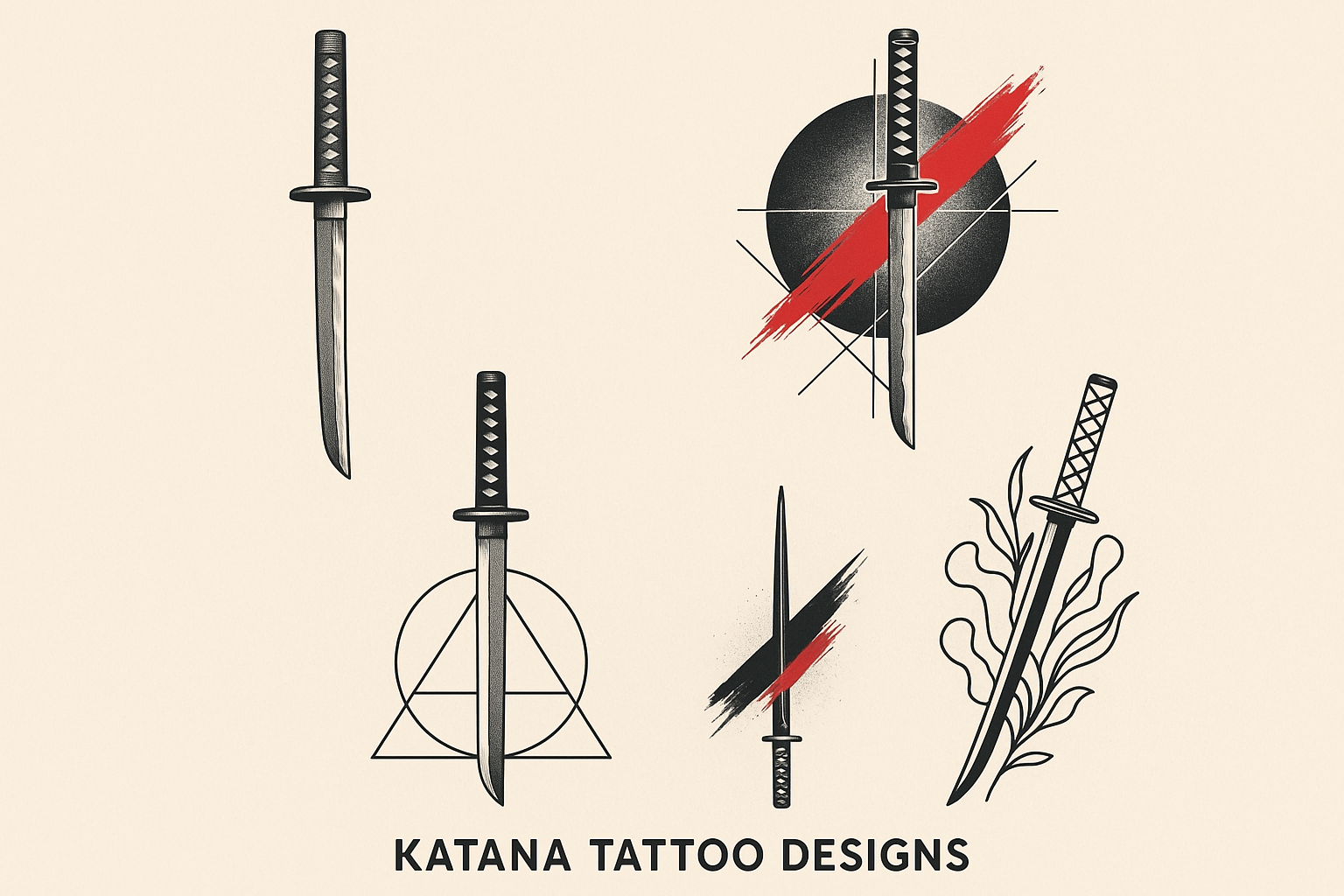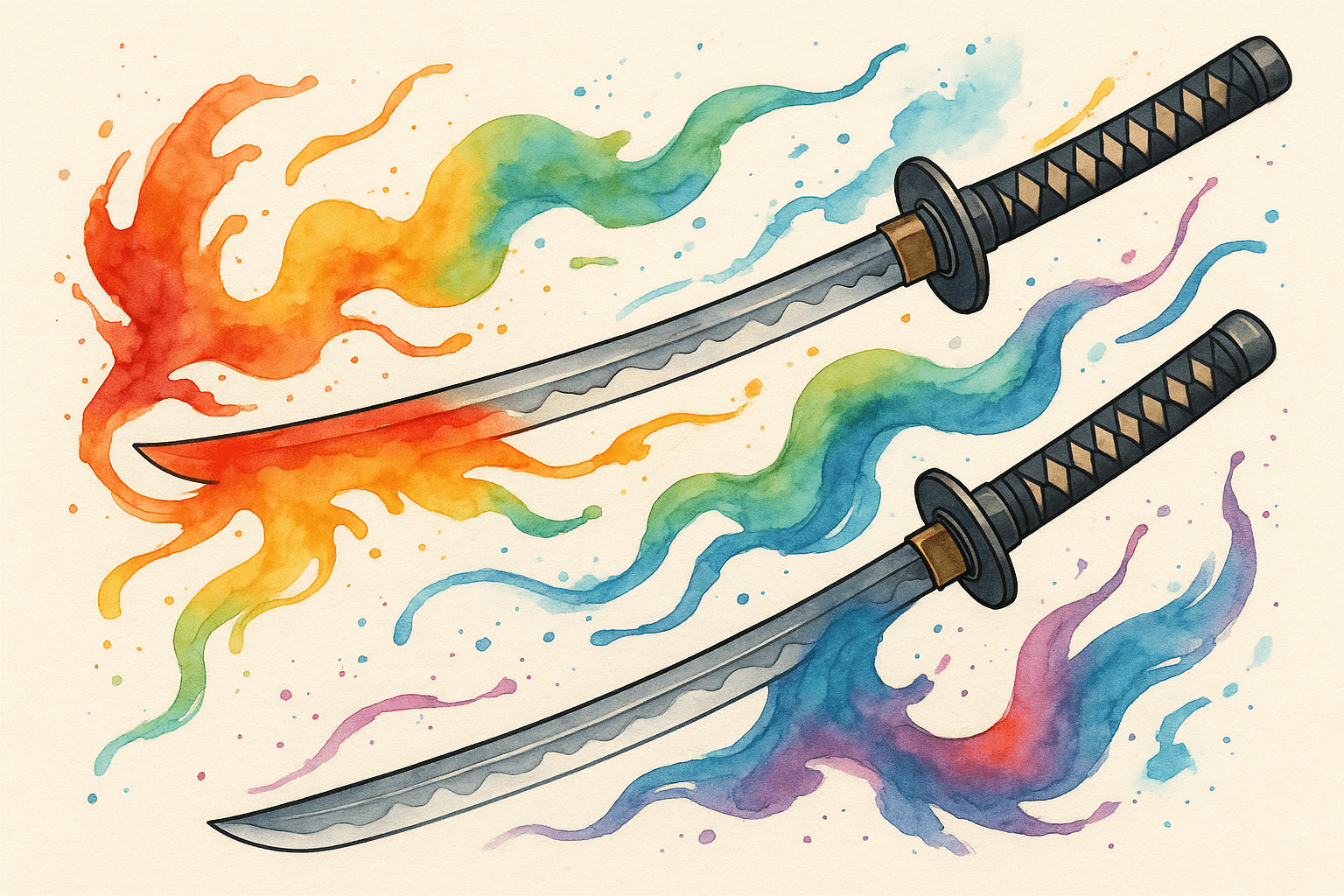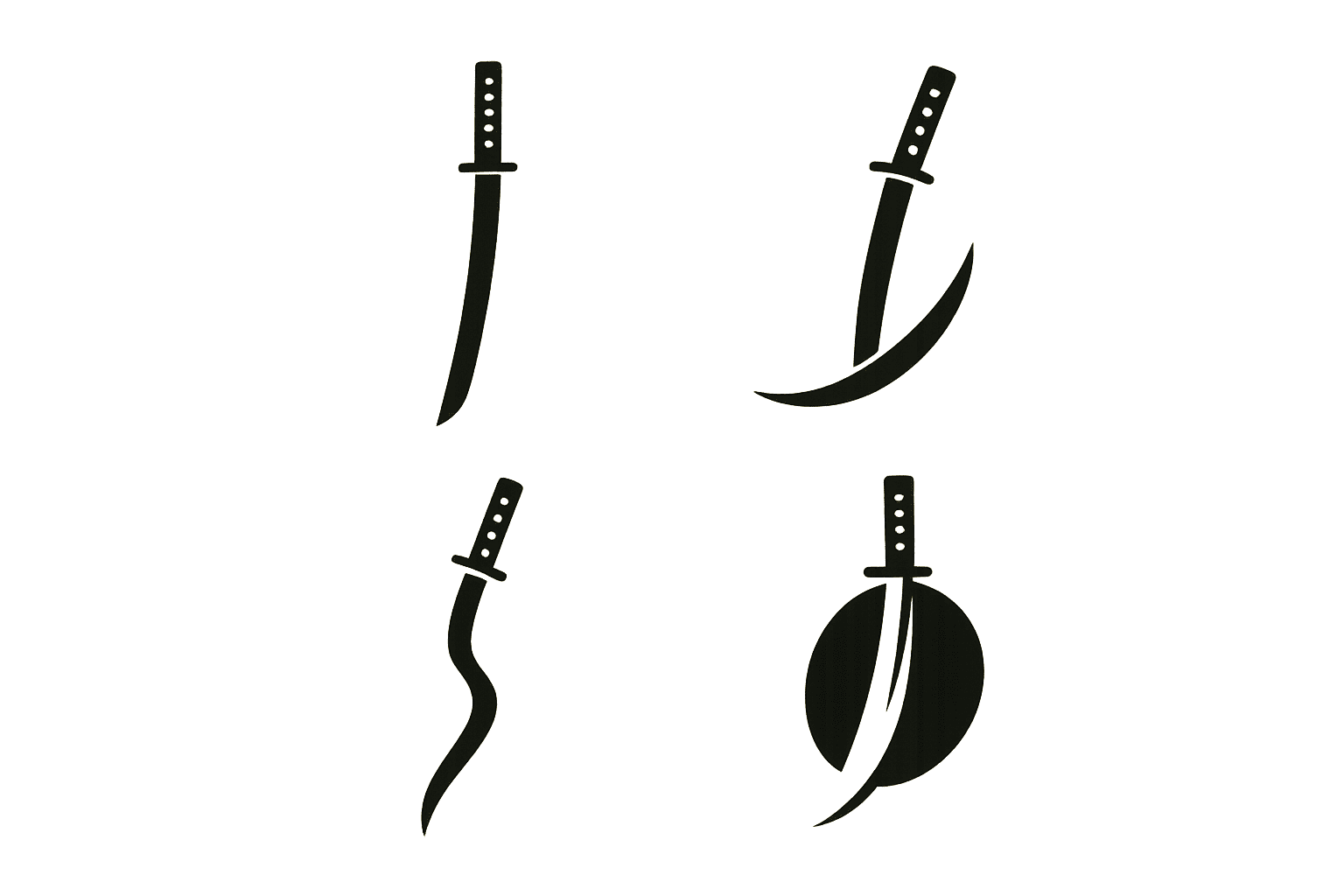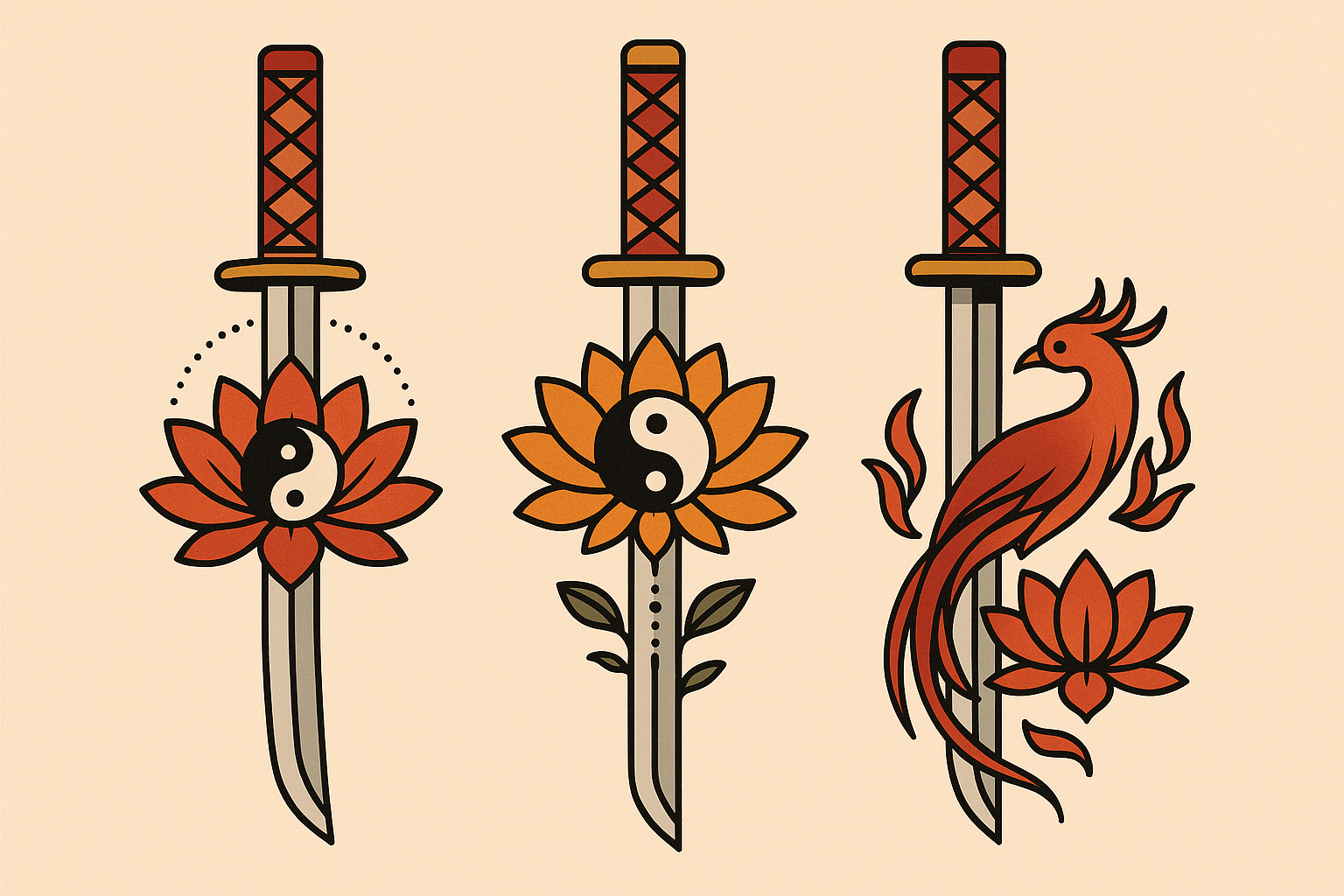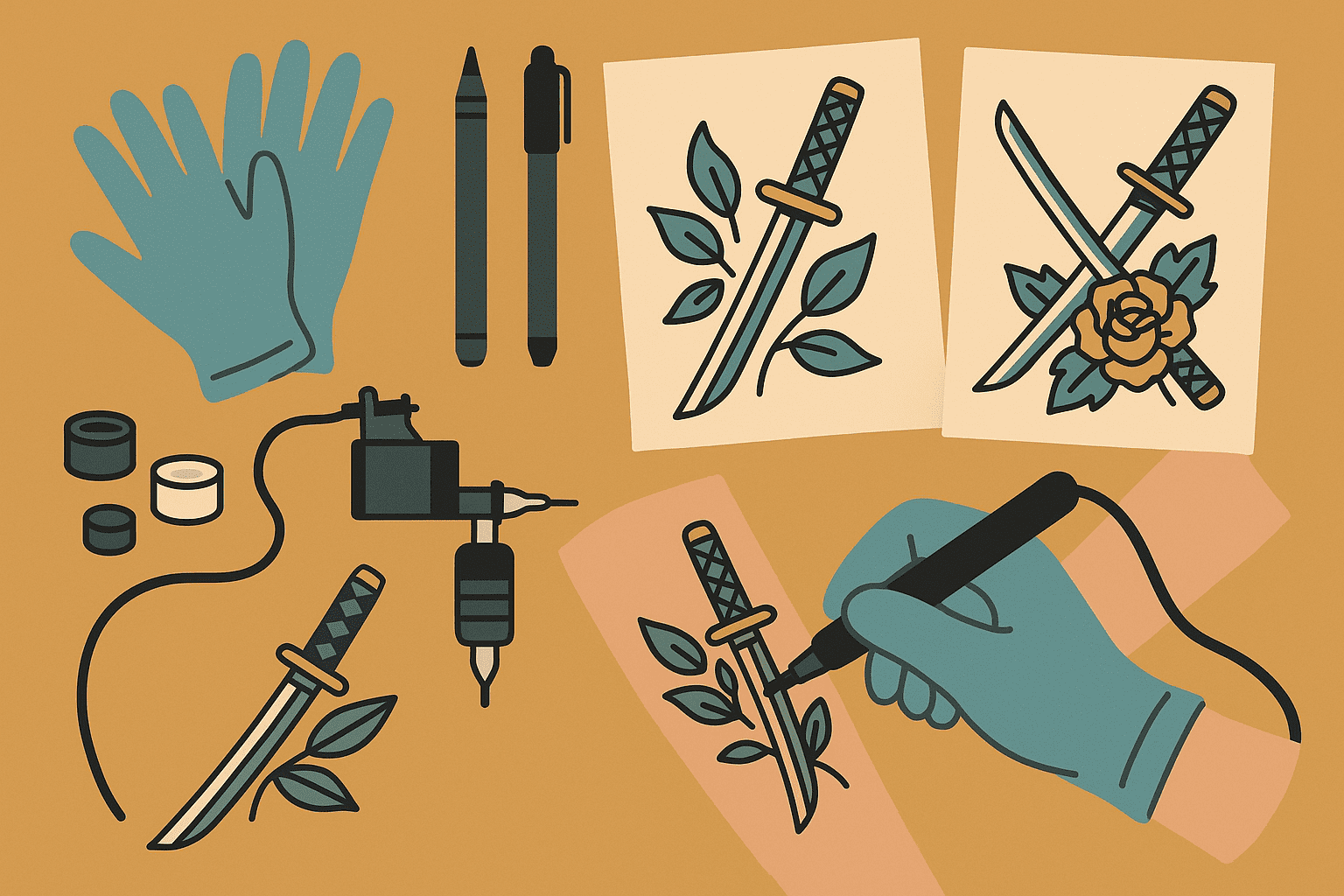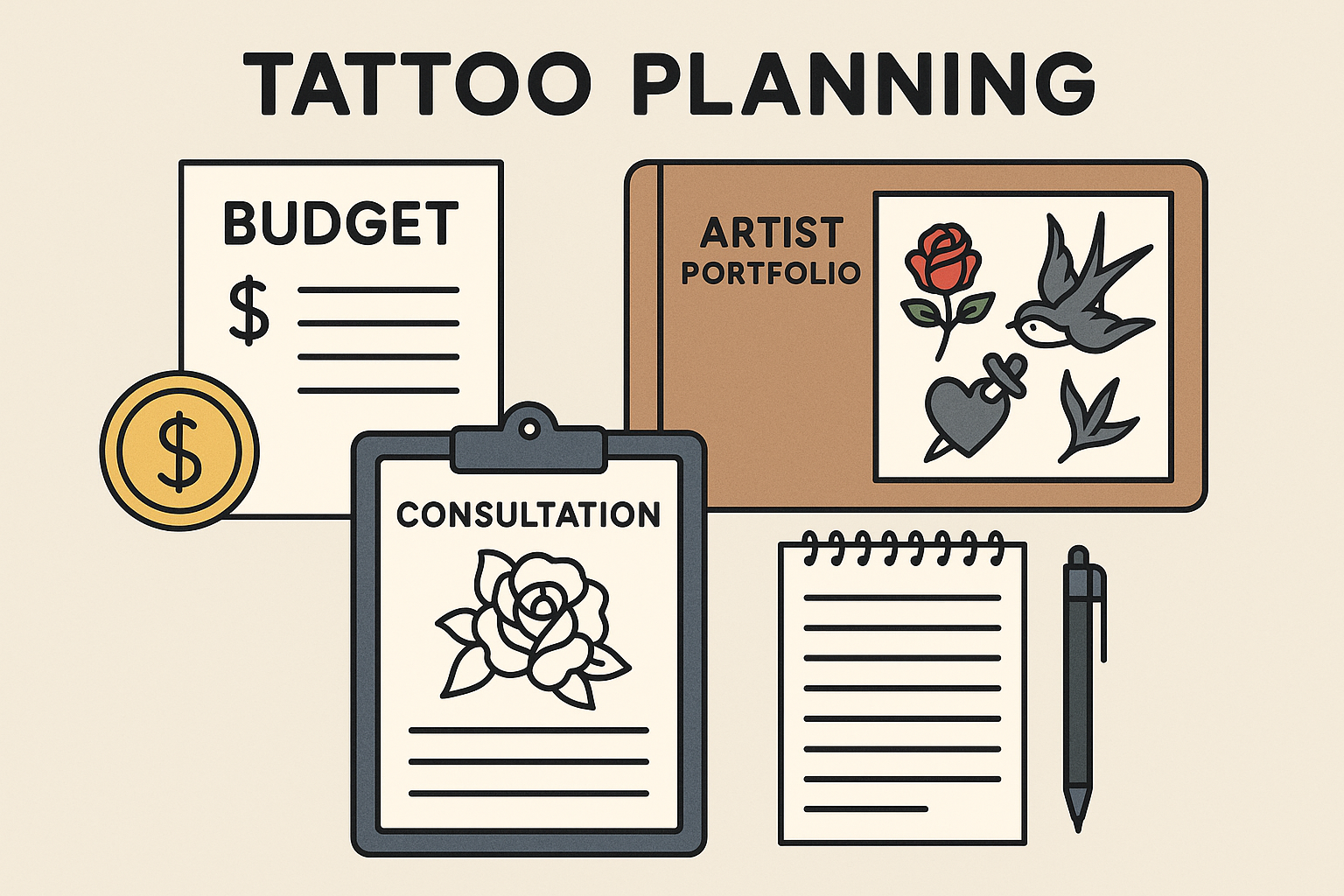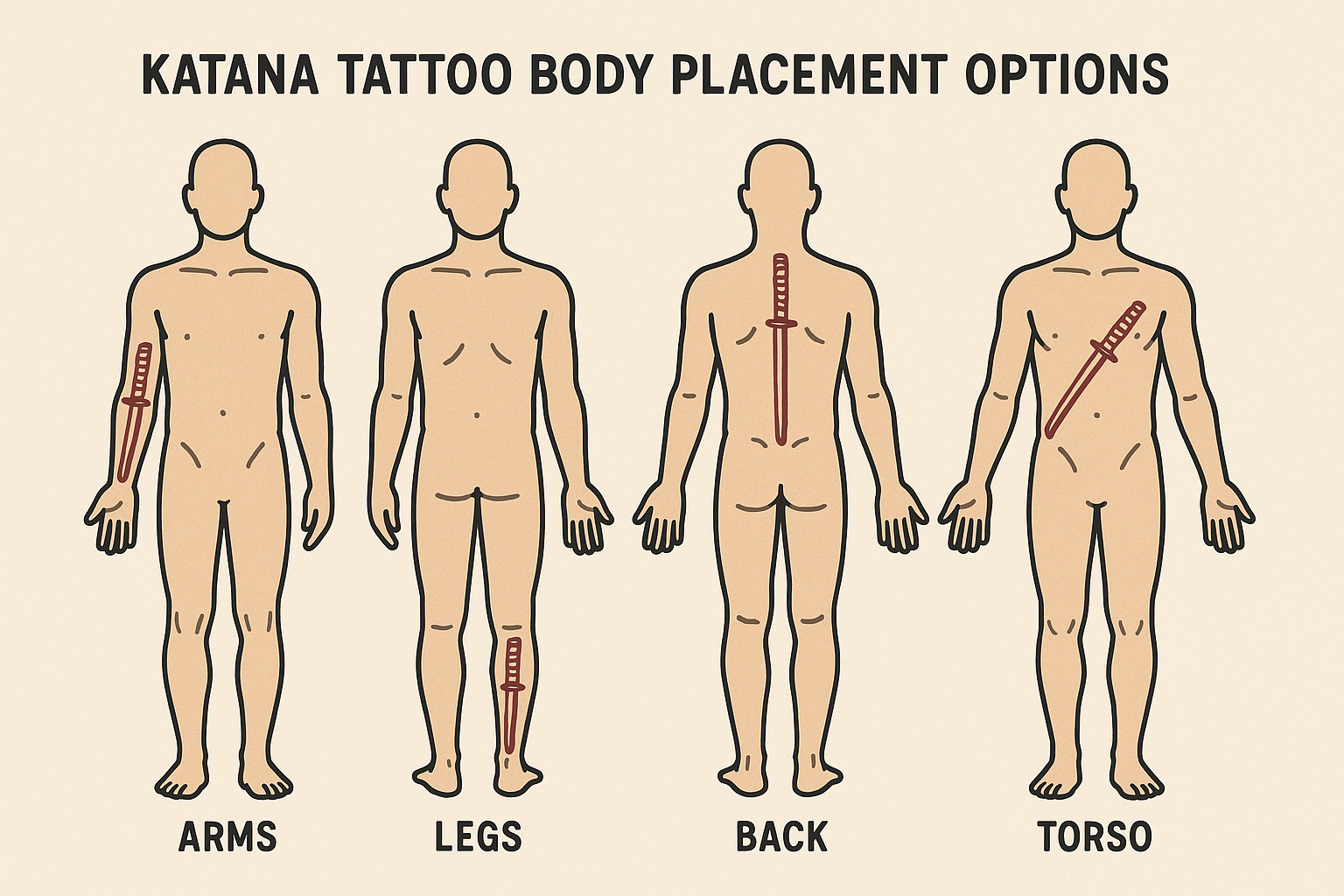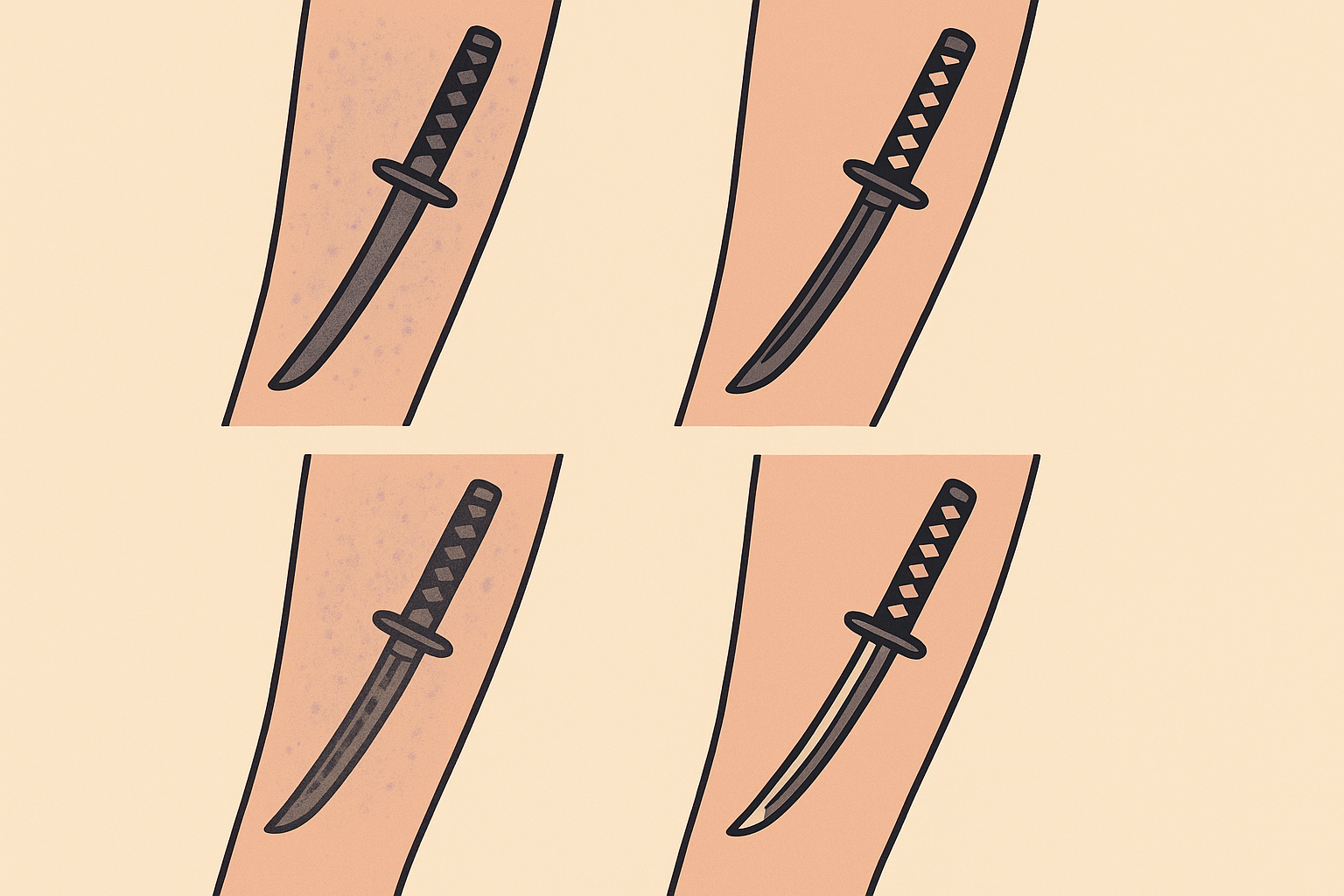25 Stunning Katana Tattoo Designs That Will Transform Your Body Art Vision
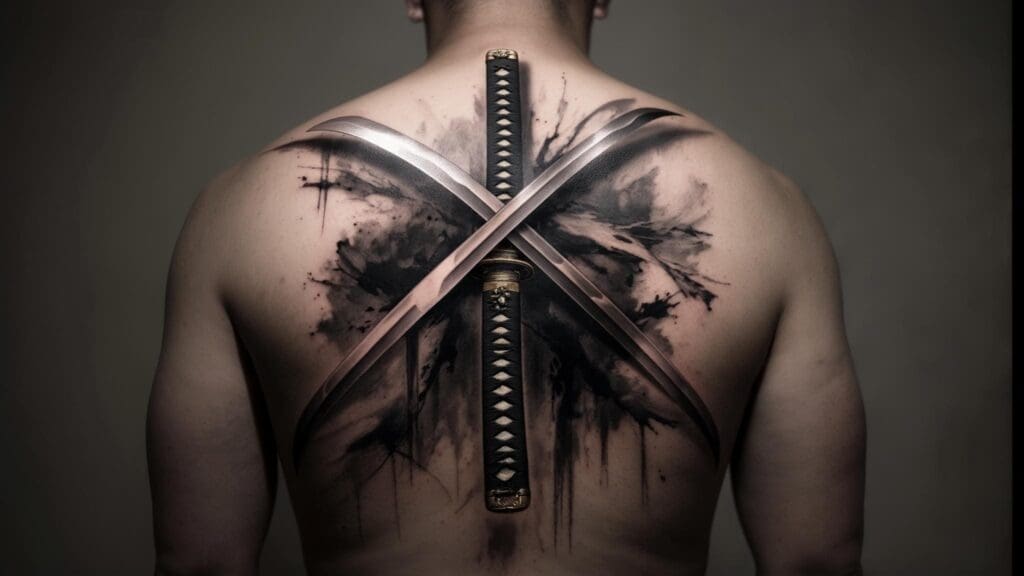
I’ve been fascinated by katana tattoos ever since I saw my first one at a local shop. There’s something about the way the curved blade flows with your body that just clicks, you know? Getting a katana tattoo has become increasingly popular among tattoo enthusiasts, with specialized studios like Katana Tattoo reporting that their artists bring over 21 years of worldwide experience specifically in creating large Japanese and American style tattoos. I remember walking into my first consultation feeling completely overwhelmed by the possibilities – the elegant curves, the symbolic weight, the technical precision required.
Here’s the thing about katana tattoos – they’re not just about looking badass (though they definitely do that). They represent honor, discipline, and the warrior spirit that has captivated people across cultures for centuries. Whether you’re drawn to intricate samurai scenes or clean minimalist blade silhouettes, choosing the right design means understanding the intersection of artistic merit, cultural respect, and personal meaning.
My buddy Jake got his katana tattoo done last year, and man, did he learn some hard lessons. He went with the cheapest artist he could find and ended up with a sword that looked more like a bent spoon. Don’t be Jake.
Table of Contents
- Essential Considerations Before Choosing Your Katana Tattoo
- Traditional Japanese Style Katana Tattoos
- Realistic and Modern Style Katana Tattoos
- Minimalist and Symbolic Katana Tattoos
- Symbolic and Spiritual Katana Tattoos
- Design Quality Assessment Across All Categories
- Technical Execution and Artist Collaboration
- Cultural Education and Respect Guidelines
- Investment Planning and Cost Considerations
- Placement Strategies for Different Body Areas
- Long-term Satisfaction and Maintenance
- How Tattoo Generator IQ Can Perfect Your Vision
TL;DR
- Traditional Japanese katana designs are absolutely stunning but need specialized artists and serious cash
- Minimalist approaches give you flexibility while staying culturally respectful
- Realistic modern styles demand master-level skills – don’t cheap out
- Do your cultural homework – research the symbolism and avoid sacred elements you don’t understand
- Placement matters big time – follow your body’s natural lines and give longer designs room to breathe
- Find artists experienced in Japanese work or realistic weapon illustration – this isn’t amateur hour
- Budget anywhere from $200-500 for simple designs to $2500+ for complex traditional pieces
- Proper aftercare is crucial for maintaining fine line work and detailed elements
Essential Considerations Before Choosing Your Katana Tattoo
Look, before you fall head over heels for that sick katana design you saw on Pinterest, let’s pump the brakes for a second. I’ve watched too many people rush into these tattoos without thinking it through, and trust me, you don’t want to be stuck with a wonky sword on your arm for the rest of your life.
Understanding tattoo pricing factors becomes crucial when planning your katana tattoo investment, as these complex designs often require premium artists and extended sessions.
Design Quality and Artistic Merit
The thing about katana tattoos is they’re not forgiving. If your artist doesn’t nail that distinctive curve – what the Japanese call “sori” – your sword’s going to look like a bent butter knife. And don’t even get me started on the guard details. I’ve seen “katanas” that look more like medieval broadswords because the artist had no clue what they were doing.
Here’s the brutal truth: most tattoo artists have never held a real katana, let alone studied one closely enough to tattoo it properly. The proportions have to be spot-on, or the whole thing falls apart. That wrapped handle (tsuka-ito) isn’t just decorative – it follows specific patterns that matter.
I remember this one guy who came into my local shop with a reference photo of some random sword he found online. Turns out it wasn’t even Japanese – it was some fantasy weapon from a video game. The artist was cool about it and educated him, but imagine if he hadn’t caught that mistake.
Cultural Sensitivity and Authenticity
Similar to traditional Japanese tattoo designs, katana tattoos require deep cultural understanding and respectful approach to honor their heritage properly. Okay, real talk time. Getting a katana tattoo when you’re not Japanese isn’t automatically cultural appropriation, but you can definitely cross that line if you’re not careful. I’ve seen people mix katanas with Celtic knots or throw in some random Chinese characters they found on Google Translate. That’s not cool.
Do your homework. Understand what you’re putting on your body. If you want to include cherry blossoms, learn why they matter in Japanese culture instead of just thinking “oh, pretty flowers.” The difference between respectful appreciation and thoughtless appropriation often comes down to whether you bothered to learn the story behind the symbols.
Consider the difference between respectful and inappropriate cultural integration: A respectful design might pair a katana with cherry blossoms (sakura) to represent the transient nature of life, a concept deeply rooted in Japanese philosophy. An inappropriate approach would be mixing a katana with Celtic knots or Viking runes, which come from entirely different cultural traditions and have no historical connection to Japanese sword culture.
Placement and Size Considerations
Here’s where a lot of people mess up – they see a massive katana design and think “I’ll just shrink it down for my wrist.” Nope. Doesn’t work that way. These swords are long for a reason, and when you compress all that detail into a tiny space, you end up with a blurry mess.
I learned this the hard way when I was planning my first piece. I wanted this elaborate design crammed onto my forearm, and my artist basically laughed and said, “Kid, that’s going to look like a smudge in five years.” He was right. We redesigned it to work with my arm’s natural lines, and it turned out a thousand times better.
Your body isn’t a flat canvas – it moves, stretches, and changes. A good katana tattoo works with your anatomy, not against it. That curve should flow with your muscle, not fight it.
| Body Area | Ideal Design Length | Recommended Styles | Technical Considerations |
|---|---|---|---|
| Forearm | 6-10 inches | Minimalist, Single katana, Abstract curves | Follows natural arm lines, good for detail work |
| Upper Arm | 8-12 inches | Traditional with elements, Realistic portraits | Wraps around muscle, consider bicep movement |
| Back/Spine | 12-18 inches | Full samurai scenes, Crossed katana, Large compositions | Maximum space, minimal distortion over time |
| Thigh | 10-14 inches | Dragon motifs, Bamboo forest, Complex traditional | Large canvas, good for color work |
| Calf | 8-12 inches | Watercolor splash, Geometric fusion, Medium complexity | Vertical orientation, visible placement |
| Chest | 6-10 inches | Memorial designs, Symbolic pieces, Horizontal layouts | Consider chest hair growth, muscle definition |
Style Compatibility and Personal Aesthetic
Your katana tattoo needs to fit with who you are and where you’re going. Traditional Japanese styles require completely different artistic approaches than modern minimalist or realistic interpretations. Think about how this design will work with your existing tattoos and whether it matches your long-term style preferences.
Consider your future tattoo plans as well. Will this katana work as a standalone piece, or do you envision it as part of a larger composition? These decisions impact everything from placement to stylistic choices. If you’re thinking about getting a katana tattoo on your ribcage because it “looks badass,” let me stop you right there. That’s prime real estate for pain, my friend. Maybe start with your arm and work your way up to the torture zones.
Traditional Japanese Style Katana Tattoos
If you’re going traditional, you better be ready to commit – both financially and time-wise. These aren’t weekend warrior tattoos. They’re serious pieces that demand serious artists and serious patience. Traditional Japanese katana tattoos represent the pinnacle of authentic cultural expression, featuring classic elements like cherry blossoms, dragons, and samurai imagery.
Similar to other Japanese traditional tattoos, katana designs follow centuries-old artistic conventions that require specialized knowledge and technique.
1. Full Samurai Katana with Cherry Blossoms
This is the holy grail of katana tattoos, and man, when it’s done right, it’s absolutely breathtaking. Picture a full katana with those delicate sakura petals floating around it – it’s like poetry written in ink.
But here’s the catch: this design will eat up your entire forearm or leg, cost you anywhere from $1,500 to $3,000, and require an artist who actually knows traditional Japanese techniques. Not the guy who watched a YouTube tutorial last week.
I watched my friend Sarah get one of these done over six months. Six months! But when it was finished, people would literally stop her on the street to compliment it. That’s the difference between doing it right and doing it cheap.
2. Katana with Dragon Motif
Holy complexity, Batman. This design is for people who want to go all-in on the traditional Japanese aesthetic. The dragon wrapping around the blade creates this incredible sense of movement and power.
Fair warning though – this is master-level stuff. You need an artist who can nail both sword proportions AND dragon scales. I’ve seen attempts at this that looked more like a lizard having a bad day with a kitchen knife. Find someone who specializes in Japanese work, or don’t bother.
3. Minimalist Single-Line Katana
Now we’re talking my language. Sometimes the most powerful designs are the simplest ones. A clean, single-line katana can be absolutely stunning when done right.
The beauty here is flexibility – you can put this on your forearm, behind your ear, wherever. It’s culturally respectful without being appropriative, and it won’t break the bank. Plus, if you want to add to it later, you’ve got options.
Just make sure your artist has steady hands. One wobbly line and your elegant katana becomes a sad noodle.
4. Katana with Koi Fish
This combination tells a beautiful story when you understand the symbolism. Koi represent perseverance and strength – they swim upstream against impossible odds. Paired with a katana, it’s like wearing a reminder to never give up.
The color work on these can be incredible, but that’s also where things get expensive. Traditional Japanese colors aren’t just pretty – they have meaning. Your artist needs to understand that, or you might end up with a rainbow fish that makes no cultural sense.
5. Samurai Helmet and Katana Composition
This is for the history buffs who want to go full samurai. When I see a well-executed piece like this, I know the person wearing it did their research. It’s not just a tattoo – it’s a tribute to an entire warrior culture.
You’ll need serious real estate for this one – we’re talking back piece territory. And finding an artist who knows the difference between different helmet styles? Good luck. Start calling around to shops that specialize in Japanese work, because your neighborhood tattoo parlor probably isn’t going to cut it.
6. Katana with Bamboo Forest
There’s something zen about this design that really speaks to me. The vertical lines of the bamboo complement the katana’s length perfectly, and the symbolism works – bamboo bends but doesn’t break, just like a true warrior’s spirit.
This one’s a bit more forgiving than some of the others. The line work is important, but you don’t need someone who can paint the Sistine Chapel on your skin. A solid artist with good composition skills can nail this.
7. Crossed Katana Design
Clean, symmetrical, and powerful. This design works great for memorial pieces or just as a statement of honor and duty. I’ve seen it done on backs, chests, and even as matching tattoos for couples (though maybe think twice about that last one).
The key here is getting the proportions exactly right. If one sword is even slightly off, the whole thing looks wonky. Measure twice, tattoo once, as they say. Well, nobody actually says that, but they should.
Realistic and Modern Style Katana Tattoos
If traditional Japanese isn’t your vibe, the realistic route can be just as impressive. These designs focus more on technical skill than cultural tradition, which gives you more creative freedom. Realistic and modern katana tattoos focus on technical precision and contemporary artistic interpretation rather than traditional Japanese styling.
8. Photorealistic Katana Portrait
This is showing-off territory for tattoo artists. When done well, it looks like someone literally embedded a photograph under your skin. Every scratch, every reflection, every detail of the handle wrapping – it’s all there.
But man, this is expensive. We’re talking $2,000+ and multiple sessions with an artist who specializes in photorealism. And if they mess up even one small detail, the whole illusion falls apart.
I saw one of these at a convention that was so realistic I actually reached out to touch it, thinking it was a real sword somehow attached to the guy’s arm. That’s when you know the artist nailed it.
A successful photorealistic katana tattoo might showcase the distinctive hamon (temper line) on the blade – the wavy pattern created during the forging process that’s unique to each sword. The artist would need to capture the subtle color variations in the steel, the way light reflects off the polished surface, and even small imperfections that give the weapon character and authenticity.
9. Broken Katana with Scattered Fragments
This design hits different. There’s something powerful about a shattered sword – it can represent overcoming trauma, transformation, or honoring someone you’ve lost.
The technical challenge here is making the break look realistic. Metal doesn’t shatter like glass, and a good artist will understand how steel actually fails. It’s these little details that separate amateur work from professional pieces.
10. Katana Emerging from Smoke/Mist
Mystical and badass at the same time. This design gives you that supernatural vibe without going full fantasy. It’s like the sword is materializing from another dimension.
The smoke effects can be tricky though. I’ve seen attempts that look more like the sword is on fire or melting. Find an artist who’s done realistic smoke before, or you might end up with something that looks like a barbecue accident.
11. Geometric Katana Fusion
This is where traditional meets contemporary, and when it works, it really works. Sacred geometry patterns integrated with the organic curves of a katana can create something truly unique.
The challenge is balance. Too much geometry and you lose the sword’s elegance. Too little and it just looks like you couldn’t decide what you wanted. A skilled artist can find that sweet spot where both elements enhance each other.
12. Katana with Modern Background Elements
Urban katana, anyone? I’ve seen these swords set against city skylines, abstract patterns, even circuit board designs. It’s a way to honor the traditional weapon while making it relevant to your modern life.
The key is making sure the elements actually work together. A katana floating in front of random modern stuff just looks confused. But when the background complements and enhances the sword’s presence, it can be really striking.
13. Watercolor Katana Splash
Watercolor tattoos are having a moment, and katanas work surprisingly well with this technique. The fluid, painterly effects create a beautiful contrast with the sword’s rigid lines.
Just remember that watercolor tattoos can be controversial in the tattoo world. Some artists swear by them, others think they don’t age well. Do your research and find someone who’s been doing watercolor work for a while, not someone experimenting with their first attempt on your skin.
Minimalist and Symbolic Katana Tattoos
Sometimes less really is more. These designs prove you don’t need a massive, complex piece to make a statement. Minimalist katana tattoos emphasize elegant simplicity and symbolic meaning over complex details. These designs offer maximum flexibility in placement and cultural approach while maintaining the sword’s essential characteristics.
For those seeking subtle body art, exploring simple tattoo ideas can provide inspiration for minimalist katana approaches that maintain impact through restraint.
14. Simple Katana Silhouette
The power of restraint. A clean, simple outline that captures the katana’s essential beauty without any fuss. It’s elegant, timeless, and won’t dominate your entire arm.
The trick with minimalist work is that every line has to be perfect. There’s nowhere to hide mistakes when you’re working with such clean, simple forms. Find an artist known for precise line work.
15. Katana with Single Symbol
Maybe it’s a single kanji character that means something to you, or a cherry blossom, or a geometric shape. The point is focus – one sword, one symbol, maximum impact.
Just please, please verify any foreign characters with a native speaker. The internet is full of horror stories about people who thought they were getting “strength” tattooed but ended up with “soup” instead.
16. Katana Hilt Only
This approach focuses on the craftsmanship aspect – all that beautiful detail work in the handle and guard without needing space for the full blade. It’s like wearing a piece of functional art.
The detail work here can be incredible. Traditional handle wrapping patterns, intricate guard designs – it’s a celebration of the katana as a work of art, not just a weapon.
17. Abstract Katana Curves
For people who want the essence of a katana without literal representation. It’s about capturing the feeling and flow of the sword through abstract lines and curves.
This is surprisingly hard to get right. Abstract doesn’t mean random – those curves need to feel intentional and evoke the katana’s distinctive shape without spelling it out literally.
18. Katana with Minimal Text
A simple sword with meaningful words – maybe a quote that inspires you, a name you want to honor, or a date that changed your life. The text becomes part of the design, not just an afterthought.
Typography matters here. The font needs to complement the sword’s aesthetic, not compete with it. And again, if you’re using a foreign language, double and triple-check the translation.
19. Negative Space Katana
This is where things get really clever. The katana shape is defined by what’s around it rather than by direct lines. It’s subtle, sophisticated, and makes people look twice.
This technique requires an artist who really understands composition and negative space. When done well, it’s brilliant. When done poorly, it just looks like something’s missing.
Symbolic and Spiritual Katana Tattoos
These designs go deeper than just “cool sword.” They’re about meaning, philosophy, and personal significance. Symbolic and spiritual katana tattoos combine the warrior’s sword with meaningful spiritual or philosophical elements, creating powerful narrative compositions.
20. Katana with Yin-Yang Integration
East meets East in a design that’s all about balance and duality. The katana can bisect the yin-yang symbol or interact with it in other meaningful ways.
This works because both elements come from Eastern philosophy and complement each other naturally. It’s not like throwing together random cultural symbols – there’s actual philosophical harmony here.
21. Katana with Lotus Flower
The contrast here is beautiful – the warrior’s weapon paired with a symbol of purity and spiritual growth. It’s about finding beauty and meaning in struggle.
The lotus has deep significance in Buddhism and Hinduism – it grows from mud but emerges clean and beautiful. Paired with a katana, it can represent the warrior’s path to enlightenment.
22. Katana with Calligraphy
When done right, this is pure poetry in ink. Japanese or Chinese characters that actually mean something, integrated seamlessly with the sword design.
But seriously, get your calligraphy verified by someone who actually speaks the language. I cannot stress this enough. Bad calligraphy tattoos are a meme for a reason.
A meaningful calligraphy integration might include the Japanese character “武” (bu), meaning “warrior” or “martial,” positioned vertically alongside a katana blade. The character’s bold strokes would complement the sword’s linear form while adding deep cultural significance. However, it’s crucial to verify the character’s meaning and proper writing with a native speaker or cultural expert to avoid embarrassing mistakes.
23. Katana with Phoenix Rising
Rebirth, transformation, rising from the ashes – this combination packs serious symbolic punch. The phoenix emerging from or surrounding the blade creates incredible visual drama.
This is another complex piece that demands serious skill. Phoenix feathers, flame effects, and making it all work with the sword’s linear form – you need an artist who can handle multiple challenging elements.
24. Katana with Sacred Geometry
Modern spirituality meets ancient weaponry. Sacred geometric patterns like the flower of life or Metatron’s cube integrated with traditional katana form.
The precision required for sacred geometry is no joke. These patterns have to be mathematically correct, or they lose their meaning and just look like random shapes.
25. Katana Memorial Design
Sometimes a tattoo is about more than just looking cool – it’s about honoring someone who mattered. Memorial katana tattoos can include dates, names, or personal symbols that tell a story.
These are deeply personal pieces that require sensitivity from your artist. Take your time with the design process and don’t rush into anything. This tattoo will carry emotional weight for the rest of your life.
Design Quality Assessment Across All Categories
Here’s the honest breakdown: traditional Japanese designs are consistently the most impressive when done right, but they’re also the easiest to screw up. You need specialized artists and serious investment.
Realistic modern pieces can be just as stunning and give you more creative freedom, but they demand technical precision that not every artist can deliver. Minimalist approaches are more forgiving and budget-friendly, but every line has to be perfect.
Symbolic pieces vary wildly depending on how well you integrate the elements. Some combinations work naturally together, others feel forced. Do your research and think about whether your chosen symbols actually complement each other or if you’re just throwing together things you like.
| Design Category | Average Cost Range | Time Investment | Skill Level Required | Cultural Sensitivity |
|---|---|---|---|---|
| Traditional Japanese | $800-$2500+ | 8-20 hours | Expert/Master | High – requires research |
| Realistic/Modern | $600-$2000 | 6-15 hours | Advanced/Master | Low – culturally neutral |
| Minimalist | $200-$800 | 2-6 hours | Intermediate/Advanced | Low – respectful approach |
| Symbolic/Spiritual | $400-$1500 | 4-12 hours | Intermediate/Advanced | Medium – depends on elements |
Technical Execution and Artist Collaboration
Understanding tattoo pain levels helps you prepare for longer sessions required by detailed katana tattoo work, especially for complex traditional designs.
Let’s talk reality for a minute. Even the most amazing design in the world can turn into a disaster if your artist doesn’t have the skills to execute it properly. This isn’t the time to bargain hunt.
When you’re talking to potential artists, ask to see their portfolio specifically for sword work or Japanese-style tattoos. If they don’t have examples, they’re probably not the right choice. And don’t be afraid to travel for the right artist – this is going on your body forever.
Size matters more than you think. A katana needs room to breathe. Trying to cram a detailed design into a small space is asking for trouble. Listen when your artist suggests sizing adjustments – they’re trying to save you from a blurry mess down the road.
Color versus black and gray is partly aesthetic preference, partly practical consideration. Black and gray ages better and costs less, but sometimes color is necessary to tell the story properly. Discuss the long-term implications with your artist.
Cultural Education and Respect Guidelines
Similar to understanding tribal tattoo meanings, katana designs require deep cultural research to avoid appropriation and ensure respectful representation.
Look, I’m not the cultural appropriation police, but I do think you should understand what you’re putting on your body. The katana isn’t just a sword – it’s a symbol of honor, discipline, and spiritual significance in Japanese culture.
Research the elements you want to include. Cherry blossoms aren’t just pretty – they represent the fleeting nature of life. Dragons aren’t just cool monsters – they’re symbols of wisdom and divine power. Understanding these meanings makes your tattoo more meaningful and shows respect for the culture.
Avoid mixing incompatible cultural elements. A katana with Celtic knots doesn’t make cultural sense and just shows you didn’t do your homework. Stick to elements that actually belong together historically and culturally.
| Cultural Element | Appropriate Use | Inappropriate Use | Respectful Integration Tips |
|---|---|---|---|
| Cherry Blossoms (Sakura) | Life’s transience, beauty, renewal | Purely decorative without meaning | Research seasonal significance, pair thoughtfully |
| Dragons (Ryu) | Wisdom, protection, divine power | Generic “cool” factor | Understand different dragon types and meanings |
| Kanji Characters | Meaningful words/concepts you embody | Random characters for appearance | Verify with native speakers, avoid sacred texts |
| Samurai Armor | Historical appreciation, warrior spirit | Costume-like superficial use | Study historical accuracy, respect warrior code |
| Geometric Patterns | Traditional artistic elements | Sacred symbols without understanding | Research spiritual significance, use appropriately |
Investment Planning and Cost Considerations
Let’s talk money because nobody likes surprises when it comes to tattoo bills. A simple minimalist katana might run you $200-500. A full traditional piece with extensive detail work? You’re looking at $800-2500, possibly more.
Photorealistic work commands premium prices because it requires master-level skills. Don’t expect to get museum-quality realism from someone charging bargain basement prices. Quality costs money, and tattoos are not the place to cut corners.
Factor in touch-ups too. Complex designs might need refreshing every few years to keep them looking crisp. And if you’re traveling to find the right artist, add travel costs to your budget. I drove six hours to get my piece done by someone who specialized in Japanese work, and it was worth every mile.
Don’t finance a tattoo you can’t afford. I’ve seen people put tattoos on credit cards and regret it later when they’re paying interest on something that’s already healed. Save up, do it right, do it once.
Placement Strategies for Different Body Areas
Your body isn’t a billboard – different areas work better for different designs, and you need to think about how your tattoo will look as you age and your body changes.
Arms are katana-friendly territory. Your forearm gives you a nice long canvas that follows the sword’s natural proportions. Upper arms work great for designs that incorporate additional elements. Just remember that arm tattoos are visible in short sleeves – make sure you’re cool with that for work and social situations.
Back pieces offer maximum real estate for elaborate compositions, but they’re also the most commitment. You can’t see your back tattoo easily, so it’s really for other people to appreciate. Plus, back work takes forever and costs a fortune.
Legs work well for vertical designs, especially thighs and calves. Thigh tattoos are easy to hide when needed, and you’ve got plenty of space to work with. Calf pieces are more visible but still professional in most settings.
Avoid ribs if you’re pain-sensitive. I don’t care how tough you think you are – rib tattoos hurt like hell, and katana designs require long sessions. Your pain tolerance might tap out before the design is finished.
Long-term Satisfaction and Maintenance
Following proper tattoo aftercare secrets becomes especially crucial for katana designs with fine line work and detailed elements that require careful healing.
Here’s what nobody tells you about tattoos: they change over time. Lines spread slightly, colors fade, and detailed work can lose its crispness. This is normal, but it’s why choosing the right design and artist matters so much.
Bold, well-spaced lines age better than fine details packed tightly together. If your artist suggests making lines thicker or spacing elements further apart, listen to them. They’re thinking about how your tattoo will look in 20 years, not just next week.
Sun protection is crucial, especially for detailed work. UV rays are tattoo killers. Use sunscreen religiously, or watch your beautiful katana fade into a blurry shadow of its former self.
Touch-ups are part of the game with complex designs. Budget for them and maintain a relationship with your artist. Most good artists will touch up their work for free within the first year, but after that, you’re paying for maintenance.
Think about future expansion too. Maybe you want just a simple katana now, but later you might want to add cherry blossoms or turn it into a full sleeve. Choose a design and placement that gives you options down the road.
How Tattoo Generator IQ Can Perfect Your Vision
Explore advanced AI tattoo generators to understand how modern technology can help perfect your katana design vision before committing to permanent ink.
Okay, here’s where technology actually helps instead of hurts. Instead of scrolling through Pinterest for hours and showing your artist some random reference photo, AI tools can help you visualize and refine your design before you commit.
The cool thing about AI-generated designs is you can experiment with different styles, placements, and elements without wasting your artist’s time or your consultation money. Want to see how that traditional katana would look with different background elements? Generate a few options and compare them.
But remember – AI is a starting point, not the finish line. Your artist still needs to adapt any design for your specific body and skin. Use these tools to explore ideas and communicate your vision, but trust your artist’s expertise for the final execution.
The educational resources that come with good AI tattoo platforms can also help you understand cultural significance and avoid embarrassing mistakes. It’s like having a research assistant that helps you make informed decisions.
Whether you’re drawn to intricate traditional samurai scenes or elegant minimalist blade silhouettes, Tattoo Generator IQ empowers you to visualize, refine, and perfect your design before making the permanent commitment. Ready to forge your perfect katana tattoo design? Experience the professional quality and comprehensive support that makes serious tattoo enthusiasts choose excellence in both artistry and cultural authenticity.
Final Thoughts
Look, getting a katana tattoo is a big decision. You’re not just choosing a design – you’re making a statement about what matters to you, and you’re wearing that statement for life.
Take your time with this process. Research the cultural significance, find the right artist, save up for quality work, and don’t rush into anything. I’ve never met anyone who regretted taking too much time to plan their tattoo, but I’ve met plenty who wished they’d slowed down and thought it through.
The best katana tattoos tell a story – about honor, about overcoming challenges, about respecting tradition while making it your own. Whatever story you want to tell, make sure your tattoo tells it clearly and beautifully.
And remember, trends come and go, but good tattoos are timeless. Choose something that will still speak to you in 30 years, not just something that looks cool on Instagram today. The warrior’s code of honor, precision, and authentic expression should guide every aspect of your katana tattoo journey – from initial concept through final execution and ongoing care.
